In today's competitive business landscape, the role of a Lead Generation Executive has become increasingly vital. Tasked with identifying and nurturing potential clients, these professionals are the backbone of any successful sales strategy. By leveraging data analytics, social media, and innovative marketing techniques, Lead Generation Executives drive growth and ensure a steady pipeline of opportunities for their organizations.
Introduction to Lead Generation Executives
Lead Generation Executives play a crucial role in the sales and marketing departments of companies. Their primary responsibility is to identify and cultivate potential customers, known as leads, who are likely to purchase a company's products or services. This involves a combination of research, outreach, and relationship-building to convert prospects into loyal customers.
- Identifying potential leads through various channels such as social media, email campaigns, and online research.
- Qualifying leads to ensure they meet the company's target customer profile.
- Maintaining and updating a database of leads and prospects.
- Collaborating with sales and marketing teams to develop strategies for lead generation.
- Utilizing tools and services like SaveMyLeads to automate and streamline the lead generation process.
Effective lead generation is essential for business growth, as it helps companies to expand their customer base and increase revenue. By leveraging modern tools and technologies, Lead Generation Executives can efficiently manage and nurture leads, ensuring a steady pipeline of potential customers. SaveMyLeads, for instance, offers seamless integration with various platforms, enabling executives to automate tasks and focus on building meaningful relationships with prospects.
Responsibilities of a Lead Generation Executive

A Lead Generation Executive is responsible for identifying and cultivating potential leads through various channels such as social media, email campaigns, and networking events. They analyze market trends and customer needs to create targeted outreach strategies. This role involves researching and compiling data on prospective clients, maintaining a robust database, and ensuring that all information is up-to-date and accurate. Effective communication and relationship-building skills are essential to engage potential customers and convert leads into sales opportunities.
Additionally, a Lead Generation Executive may be tasked with setting up and managing integrations with CRM systems and other marketing tools to streamline the lead generation process. Utilizing services like SaveMyLeads can significantly enhance efficiency by automating data transfer between different platforms, ensuring that no lead is missed. They also collaborate closely with the sales and marketing teams to align lead generation efforts with overall business goals, track performance metrics, and adjust strategies as needed to maximize results.
Best Practices for Lead Generation

Effective lead generation is crucial for any business looking to grow its customer base and increase revenue. To ensure success, it is important to follow best practices that can streamline the process and improve results.
- Identify Your Target Audience: Understand who your ideal customers are and tailor your lead generation efforts to meet their needs.
- Create High-Quality Content: Develop engaging and informative content that addresses the pain points of your target audience and encourages them to take action.
- Utilize Multiple Channels: Diversify your lead generation efforts by leveraging various channels such as social media, email marketing, and SEO to reach a broader audience.
- Implement Lead Scoring: Use lead scoring to prioritize leads based on their likelihood to convert, allowing your sales team to focus on the most promising prospects.
- Integrate Automation Tools: Utilize services like SaveMyLeads to automate and streamline lead capture, ensuring that no potential lead slips through the cracks.
By adhering to these best practices, businesses can optimize their lead generation strategies, resulting in higher conversion rates and sustained growth. Continuous monitoring and adjustment of these practices will further enhance their effectiveness over time.
Role of Technology in Lead Generation

Technology plays a pivotal role in modern lead generation strategies. With advancements in software and automation tools, businesses can now streamline their lead generation processes, making them more efficient and effective. By leveraging technology, companies can collect and analyze vast amounts of data to identify potential leads and tailor their marketing efforts accordingly.
One of the primary ways technology aids in lead generation is through the use of Customer Relationship Management (CRM) systems. These systems enable businesses to manage their interactions with current and potential customers, ensuring that no opportunity is missed. Additionally, marketing automation tools can help in nurturing leads through personalized email campaigns and targeted advertising.
- Automated lead scoring and prioritization
- Integration with social media platforms for lead capture
- Real-time analytics and reporting
- Seamless integration with other business tools via services like SaveMyLeads
Services like SaveMyLeads simplify the process of integrating various marketing and sales tools, ensuring that data flows seamlessly between them. This not only saves time but also enhances the accuracy and effectiveness of lead generation efforts. By automating routine tasks, businesses can focus more on strategy and engagement, ultimately driving better results.
Career Path for Lead Generation Executives
The career path for Lead Generation Executives typically begins with an entry-level position where one gains foundational skills in identifying and qualifying potential leads. As they develop their expertise, they may take on more responsibilities such as managing lead databases, conducting market research, and utilizing CRM tools. A crucial aspect of their role involves setting up integrations to streamline lead management processes. Services like SaveMyLeads can be particularly beneficial, as they automate lead data transfer, ensuring seamless integration with various marketing and sales platforms.
With experience, Lead Generation Executives can advance to senior roles where they oversee a team, develop lead generation strategies, and collaborate closely with the sales and marketing departments. Continuous learning and staying updated with the latest tools and technologies are essential for growth in this field. Eventually, they may progress to managerial positions such as Lead Generation Manager or Director of Lead Generation, where they shape the overall lead generation strategy and drive the company's growth initiatives.
FAQ
What does a Lead Generation Executive do?
What skills are essential for a Lead Generation Executive?
How can automation tools help in lead generation?
What are the main challenges faced by Lead Generation Executives?
How do you measure the success of lead generation efforts?
What do you do with the data you get from Facebook lead forms? Do you send them to the manager, add them to mailing services, transfer them to the CRM system, use them to implement feedback? Automate all of these processes with the SaveMyLeads online connector. Create integrations so that new Facebook leads are automatically transferred to instant messengers, mailing services, task managers and other tools. Save yourself and your company's employees from routine work.
